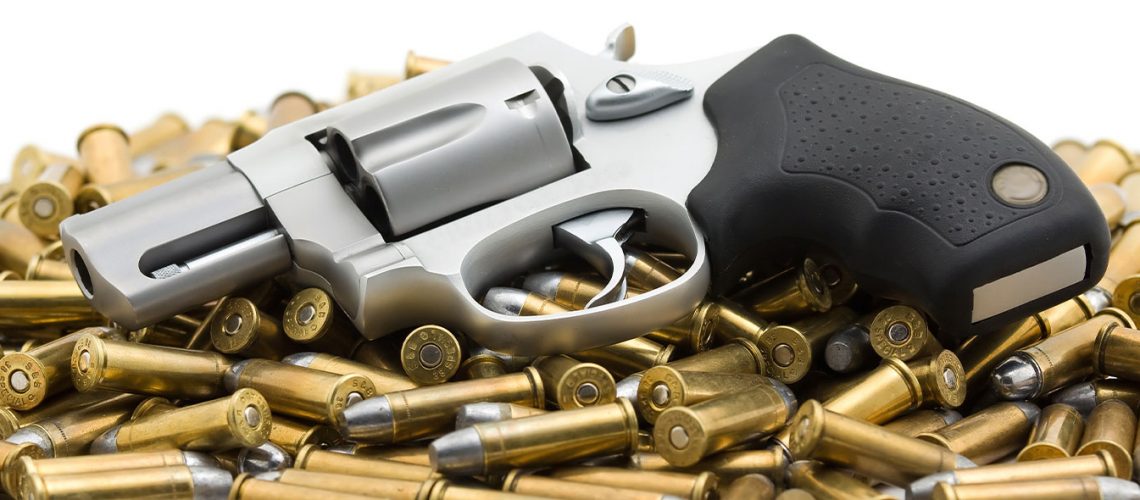You may have heard the terms “single action” or “double action” and others to describe how a gun fires. Or maybe you’ve heard terms about the way a revolver is loaded—like “hinge loader” or “swing out”. Well, there’s no need to let the mystery of these terms continue any further.
The definitions are really quite simple, and will help you to understand how the revolver actually works.
For starters, a revolver is just what it sounds like—and it’s a type of handgun you’ve seen in countless Westerns. It’s a handgun with a revolving “cylinder” that holds cartridges (or powder, a round lead ball, and a percussion cap originally.)
The cylinder “revolves” to position a cartridge in a chamber in front of the hammer after each shot. The hammer strikes the primer on the back of the cartridge, which causes the gun to fire.
There are a few ways to make this happen. Which leads to those terms you’ve been hearing.

Single Action
To simplify things, the first thing to remember about these terms is that they’re referring to the trigger, and what it does (and doesn’t do) in each operation.
With a single action revolver, the trigger is responsible for one single action. All it does is release the hammer. To get the firearm to “revolve” and position the next bullet in front of the hammer, the shooter must pull back the hammer manually themselves.
Pulling back the hammer cocks the firearm, readying it for the next firing, and revolves the cylinder to position the next chamber.
The one single thing the trigger does is release the hammer. Thus, a single action revolver.
Single action revolvers also have a “half-cock” position to serve as a safety, so that the firing pin is not resting directly on or over the primer. (Hence the origin of yet another expression—“going off half-cocked” is something that is improperly initiated and should not be done.) Even with the half-cock position, many older single action designs were not safe to carry with the hammer over a loaded chamber. A proficient and safe shooter would carry 5 cartridges and one empty chamber. Modern single actions use a transfer bar and are safe to carry with all chambers loaded.

Double Action
As the term indicates, the trigger performs two actions for a double action revolver.
The first thing is that pulling the trigger rotates the cylinder to position the next shot. The second action is to release the hammer, firing the gun. So, the revolver needn’t be cocked to be ready to fire. The trigger in a double action revolver takes care of all that.
The trigger on a double action revolver is a longer and harder pull, because the trigger pull is doing more work.
The vast majority of double action revolvers can also be fired in a single action fashion by cocking the hammer back, at which point the trigger merely releases the hammer. When fired in this method, the trigger pull is often short and crisp. If time allows, the shooter may manually cock the hammer to take a more precise shot.
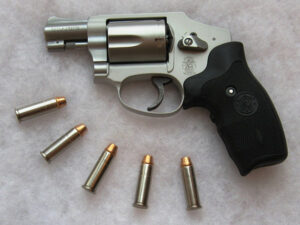 Double Action Only
Double Action Only
This is a double action revolver that doesn’t allow for cocking the hammer back other than by the trigger.
In fact, some Double Action Only revolvers don’t have a visible hammer at all. The trigger merely functions to rotate to the next chamber and cause an internal hammer to strike the bullet to fire the gun.
In these cases, sometimes that hammer is covered by the revolver’s frame, sometimes it’s a hammer with a smooth edge and little area to allow it being cocked back. Less accurate than single action designs or double action designs that can be fired in single action, these revolvers are often very compact designs, intended for personal defense at extremely close range.
In addition to terms about the firing action of a revolver, there are also a number of terms that refer to how a revolver is loaded.

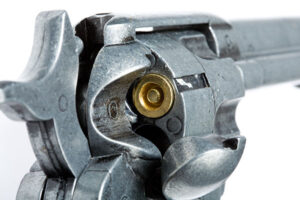 Loading Gate/Fixed Cylinder
Loading Gate/Fixed Cylinder
This type of revolver features a cylinder that doesn’t swivel or pivot outside the revolver.
At the side of the rear of the revolver, there’s a small door or “gate” that opens to load or unload bullets. Due to the fixed nature of the revolver around the cylinder, this revolver can fire very powerful bullets.
A rod under the barrel known as an “extractor” pushes the spent cartridges out of the cylinder through the loading gate.
The disadvantage of a revolver of this design is that it can only be loaded and unloaded one bullet at a time.
 Hinge Loaders/Top Break
Hinge Loaders/Top Break
This type of revolver features a hinge that swivels the cylinder forward along with the barrel of the gun, exposing the cylinder for loading and unloading purposes.
Sometimes, this type of revolver has an extractor lever that pushes forward when the gun is “open” so that cartridges or empty cases are pushed forward for simple removal, or ejected completely.
Obviously, it’s an advantage over the fixed cylinder in that all the bullets can be extracted or loaded at one time—reducing the time necessary to do so. The disadvantage is that this design is not as structurally sound as the loading gate and can’t be used for cartridges that are as high-powered as ones used with the loading gate/fixed cylinder; this, you probably won’t see this action on a 460 magnum, or any other extremely high-pressure cartridge.

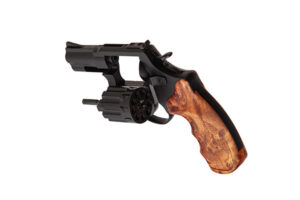 Swing Out
Swing Out
The swing out cylinder makes use of a pivot that swings the cylinder out and down, to the side of the firearm.
A rod running down the center of the cylinder both unlocks the cylinder, allowing it to swing out—and will extract or eject fired cartridges when pushed in.
More structurally sound than the top break design, it’s still not as strong as the fixed cylinder. However, it’s much faster to load and unload than the fixed cylinder.
Speaking of speed in loading, there’s another term that will come in handy.
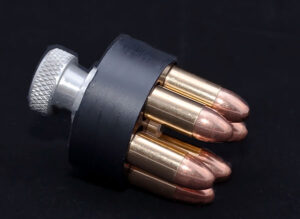 Speed Loader
Speed Loader
A speed loader holds a number of bullets in a circle—corresponding directly with the cylinder of the revolver you’re loading.
Just line up the speed loader with the cylinder, and unlock it. It will release all the bullets into the cylinder.
Some revolvers use clips (yes, clips, not magazines) in a “full moon” or “half-moon” shape to hold ammunition in the proper arrangement and allow for quick loading. Revolver cartridges have historically always been cartridges with a rimmed case, but some newer designs that use moon or half-moon clips allow revolvers to fire rimless cartridges like 9mm or 45 ACP.
A revolver is a very simple firearm. Its design is not complicated, nor is its operation. So, the terms surrounding it and their meanings also are very basic, and easy to understand.
Taking some time to get to know them will not only educate you as to the different types of revolvers available, but how the firearms operate so that you can appreciate which one will suit you best for your needs.
